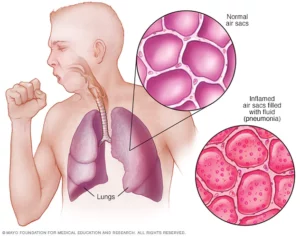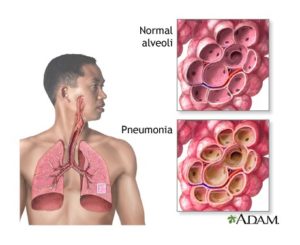What is Pneumonia?
Respiratory diseases are rampant today because it is easier spread in crowded areas. Pneumonia is one of the most common respiratory problems and it affects all stages of life.


- Pneumonia is an inflammation of the lung parenchyma caused by various microorganisms, including bacteria, mycobacteria, fungi, and viruses.
- Pneumonitis is a more general term that describes the inflammatory process in the lung tissue that may predispose and place the patient at risk for microbial invasion.
Statistics by UNICEF on Pneumonia.
A child dies of pneumonia every 39 seconds.
Pneumonia kills more children than any other infectious disease, claiming the lives of over 800,000 children under five every year, or around 2,200 every day. This includes over 153,000 newborns. Almost all of these deaths are preventable. Globally, there are over 1,400 cases of pneumonia per 100,000 children, or 1 case per 71 children every year, with the greatest incidence occurring in South Asia (2,500 cases per 100,000 children) and West and Central Africa (1,620 cases per 100,000 children). According to the latest WHO data published in 2018 Influenza and Pneumonia Deaths in Cameroon reached 24,139 or 11.47% of total deaths. The age adjusted Death Rate is 145.79 per 100,000 of population ranks Cameroon #10 in the world
Classification of pneumonia.
Pneumonia is classified into four: community-acquired pneumonia (CAP) and hospital-acquired pneumonia (HAP), pneumonia in the immunocompromised host, and aspiration pneumonia.

Community-Acquired Pneumonia
- CAP occurs either in the community setting or within the first 48 hours after hospitalization.
- The causative agents for CAP that needs hospitalization include streptococcus pneumoniae, H. influenza, Legionella, and Pseudomonas aeruginosa.
- Only in 50% of the cases does the specific etiologic agent become identified.
- Pneumonia is the most common cause of CAP in people younger than 60 years of age.
- Viruses are the most common cause of pneumonia in infants and children.
Hospital-Acquired Pneumonia
- HAP is also called nosocomial pneumonia and is defined as the onset of pneumonia symptoms more than 48 hours after admission in patients with no evidence of infection at the time of admission.
- HAP is the most lethal nosocomial infection and the leading cause of death in patients with such infections.
- Common microorganisms that are responsible for HAP include Enterobacter species, Escherichia coli, influenza, Klebsiella species, Proteus, Serratia marcescens, S. aureus, and S. pneumonia.
- The usual presentation of HAP is a new pulmonary infiltrate on chest x-ray combined with evidence of infection.
Pneumonia in the Immunocompromised Host
- Pneumonia in immunocompromised hosts includes Pneumocystis pneumonia, fungal pneumonias and Mycobacterium tuberculosis.
- Patients who are immunocompromised commonly develop pneumonia from organisms of low virulence.
- Pneumonia in immunocompromised hosts may be caused by the organisms also observe in HAP and CAP.
Aspiration Pneumonia
- Aspiration pneumonia refers to the pulmonary consequences resulting from entry of endogenous or exogenous substances into the lower airway.
- The most common form of aspiration pneumonia is a bacterial infection from aspiration of bacteria that normally reside in the upper airways.
- Aspiration pneumonia may occur in the community or hospital setting.
- Common pathogens are S. pneumonia, H.influenza, and S. aureus.
Pathophysiology of Pneumonia.
Having an idea about the disease process helps the patient understand the treatment regimen and its importance, increasing patient compliance.
- Pneumonia arises from normal flora present in patients whose resistance has been altered or from aspiration of flora present in the oropharynx.
- An inflammatory reaction may occur in the alveoli, producing exudates that interfere with the diffusion of oxygen and carbon dioxide.
- White blood cells also migrate into the alveoli and fill the normally air-filled spaces.
- Due to secretions and mucosal edema, there are areas of the lung that are not adequately ventilated and cause partial occlusion of the alveoli or bronchi.
- Hypoventilation may follow, causing ventilation-perfusion mismatch.
- Venous blood entering the pulmonary circulation passes through the under ventilated areas and travels to the left side of the heart deoxygenated.
- The mixing of oxygenated and poorly oxygenated blood can result to arterial hypoxemia.
Causes of Pneumonia
Each type of pneumonia is caused by different and several factors.
Community-Acquired Pneumonia
- Streptococcus pneumoniae. This is the leading cause of CAP in people younger than 60 years of age without comorbidity and in those 60 years and older with comorbidity.
- Haemophilus influenzae. This causes a type of CAP that frequently affects elderly people and those with comorbid illnesses.
- Mycoplasma pneumoniae.
Hospital-Acquired Pneumonia
- Staphylococcus aureus. Staphylococcus pneumonia occurs through inhalation of the organism.
- Impaired host defenses. When the defenses of the body are down, several pathogens may invade the body.
- Comorbid conditions. There are several conditions that lower the immune system, causing bacteria to pool in the lungs and eventually result in pneumonia.
- Supine positioning. When the patient stays in a prolonged supine position, fluid in the lungs pools down and stays stagnant, making it a breeding place for bacteria.
- Prolonged hospitalization. The risk for hospital infections or nosocomial infections increases the longer the patient stays in the hospital.
Clinical Manifestations
Pneumonia varies in its signs and symptoms depending on its type but it is not impossible to diagnose a specific pneumonia through its clinical manifestation
- Rapidly rising fever. Since there is inflammation of the lung parenchyma, fever develops as part of the signs of an infection.
- Pleuritic chest pain. Deep breathing and coughing aggravate the pain in the chest.
- Rapid and bounding pulse. A rapid heartbeat occurs because the body compensates for the low concentration of oxygen in the body.
- Tachypnea. There is fast breathing because the body tries to compensate for the low oxygen concentration in the body.
- Purulent sputum. The sputum becomes purulent because of the infection in the lung parenchyma which produced sputum-filled with pus.
Prevention
It is better to prevent the occurrence of pneumonia instead of treating the disease itself. Here are several ways that can help prevent pneumonia.
- Pneumococcal vaccine. This vaccine can prevent pneumonia in healthy patients with an efficiency of 65% to 85%.
- Staff education. To help prevent HAP, the CDC (2004) encouraged staff education and involvement in infection prevention.
- Infection and microbiologic surveillance. It is important to carefully observe the infection so that there could be an appropriate application of prevention techniques.
- Modifying host risk for infection. The infection should never be allowed to descend on any host, so the risk must be decreased before it can affect one.
Complications of Pneumonia
Pneumonia has several complications if left untreated or the interventions are inappropriate. These are the following complications that may develop in patients with pneumonia.
- Shock and respiratory failure. These complications are encountered chiefly in patients who have received no specific treatment and inadequate or delayed treatment.
- Pleural effusion. In pleural effusion, the fluid is sent to the laboratory for analysis, and there are three stages: uncomplicated, complicated, and thoracic empyema.
